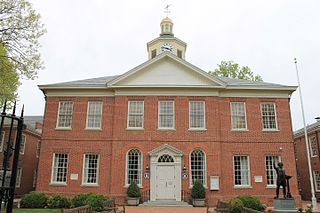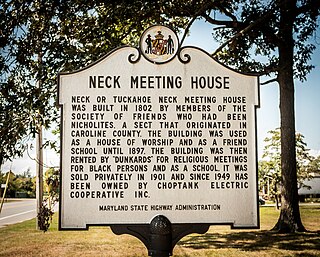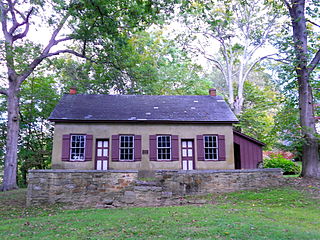
Talbot County is a county located in the heart of the Eastern Shore of Maryland in the U.S. state of Maryland. As of the 2010 census, the population was 37,782. Its county seat is Easton. The county was named for Lady Grace Talbot, the wife of Sir Robert Talbot, an Anglo-Irish statesman, and the sister of Lord Baltimore.
In the Religious Society of Friends (Quakers), a monthly meeting or area meeting is the basic governing body, a congregation which holds regular meetings for business for Quakers in a given area. The monthly meeting is responsible for the administration of its congregants, including membership and marriages, and for the meeting's property. A monthly meeting can be a grouping of multiple smaller meetings, usually called preparative meetings, coming together for administrative purposes, while for others it is a single institution. In most countries, multiple monthly meetings form a quarterly meeting, which in turn form yearly meetings. Programmed Quakers may refer to their congregation as a church.

A meeting house is a building where religious and sometimes public meetings take place.

A Friends meeting house is a meeting house of the Religious Society of Friends (Quakers), where meeting for worship is usually held. Typically Friends meeting houses do not have steeples.

The Benjaminville Friends Meeting House and Burial Ground is a Friends Meeting House of the Religious Society of Friends (Quakers), located north of the rural village of Holder in McLean County, Illinois. It was once the site of a now-defunct village called Benjaminville, founded in 1856 after Quakers settled the area. More Quakers followed, and the burial ground, then the current meeting house in 1874, were constructed. This site, listed on the U.S. National Register of Historic Places since 1983, is all that remains of that village.

Galesville is an unincorporated town and census-designated place (CDP) in Anne Arundel County, Maryland, United States. As of the 2010 census, it had a population of 685.

The Sandy Spring Friends Meetinghouse is a historic building located at Sandy Spring, Montgomery County, Maryland. It is a large, Flemish bond brick, Federal-style Quaker Meeting House built in 1817. The meetinghouse is on two acres deeded by James Brooke in the 1750s, for the use of the Quaker Meeting. Nearby is the cemetery where he and many of his descendants were buried.

The Neck Meetinghouse and Yard, also known as the Quaker Meetinghouse & Graveyard, is a historic Quaker meetinghouse located at West Denton, Caroline County, Maryland. It is a one-story rectangular frame building with a pitched gable roof measuring 30 feet, 81⁄2 inches long and 20 feet, 5 inches deep. In the graveyard are six marked burials with stones dating from the 1850s to 1890, with some more recent interments. It is the only extant Friends meeting house in Caroline County, and one of only a few still standing on the Eastern Shore. The meeting house was utilized from September 26, 1802, when the first meeting was held in the building, until it was abandoned in 1890 for lack of funds and participants.

The Colora Meetinghouse is a historic Friends meeting house located at Colora, Cecil County, Maryland, United States.

The Little Falls Meetinghouse is a historic Friends meeting house located at Fallston, Harford County, Maryland, United States. It was constructed in 1843 and is a sprawling one-story fieldstone structure with shallow-pitched gable roof and a shed-roofed porch. The building replaced an earlier meetinghouse built in 1773. Also on the property is a cemetery and a one-story frame mid-19th century school building, with additions made post-1898 and in 1975. It features the characteristic two entrance doors and a sliding partition dividing the interior into the men's and women's sides. The Friends currently meet on the former men's side of the meetinghouse, and the women's side is only used for large groups and special occasions.

Old Kennett Meetinghouse is a historic meeting house of the Religious Society of Friends or "Quakers" in Kennett Township near Chadds Ford, Pennsylvania.

Chichester Friends Meetinghouse is a historic Quaker meeting house at 611 Meetinghouse Road near Boothwyn, in Upper Chichester Township, Delaware County, Pennsylvania. This area, near Chester, was one of the earliest areas settled by Quakers in Pennsylvania. The meetinghouse, first built in 1688, then rebuilt after a fire in 1769, reflects this early Quaker heritage. The building was added to the National Register of Historic Places in 1973.

Appoquinimink Friends Meetinghouse, also known as the Odessa Friends Meetinghouse, is a very small but historic Quaker meetinghouse on Main Street in Odessa, Delaware. It was built in 1785 by David Wilson and added to the National Register of Historic Places in 1972. Members of the meeting, including John Hunn and his cousin John Alston, were active in the Underground Railroad and Harriet Tubman may have hid in the meetinghouse. Measuring about 20 feet (6.1 m) by 22 feet (6.7 m), it may be the smallest brick house of worship in the United States.

The Raisin Valley Friends Meetinghouse is a historic church located at 3552 North Adrian Highway (M-52) in Adrian Charter Township about two miles (3.2 km) north of the city of Adrian in central Lenawee County, Michigan. It was added to the National Register of Historic Places on April 28, 1982 and later designated as a Michigan Historic Site on January 23, 1992. It houses the oldest Quaker congregation in Michigan, which was established in 1831. It is also recognized as the second oldest continuously operating church building in the state of Michigan after the Mission Church in Mackinac Island, which was built in 1829.

Friends Meetinghouse is a historic Quaker meeting house at 4th and West Streets in Wilmington, Delaware in the Quaker Hill neighborhood. The meeting is still active with a membership of about 400 and is part of the Philadelphia Yearly Meeting. It was built in 1815–1817 and added to the National Register of Historic Places in 1976.

Twelfth Street Meeting House was a Quaker meeting house in Philadelphia, Pennsylvania. It was built on the west side of 12th Street, south of Market Street, 1812–13, incorporating architectural elements from Philadelphia's Greater Meeting House (1755).
Friends meeting houses are places of worship for the Religious Society of Friends, or Quakers. A "meeting" is the equivalent of a church congregation, and a "meeting house" is the equivalent of a church building.

The Roaring Creek Friends Meeting House is a historic place of worship for members of the Religious Society of Friends, or Quakers, in rural Columbia County, Pennsylvania, near Numidia on Quaker Meeting House Road.

Chester Friends Meetinghouse is a Quaker meeting house at 520 East 24th Street in Chester, Delaware County, Pennsylvania, United States.


















